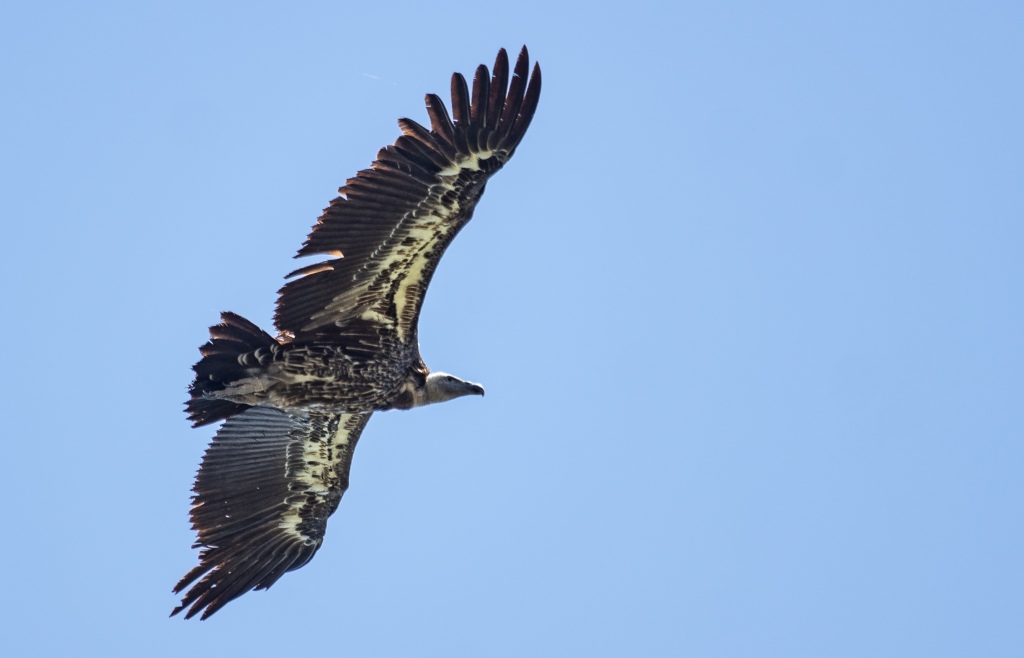Tagging and studying the movements of a Critically Endangered and increasingly vagrant Vulture species.

Current species status
The Rüppell´s Vulture was first considered a species of conservation concern in 2007, when it was listed as Near Threatened. Following severe decline in several parts of its range, suspicion of very rapid overall decline, and likelihood of continuing reduction in numbers, it was upgraded to Endangered in 2012 and, in 2015, to Critically Endangered.
Main threats
Both primary and secondary poisoning are thought to be key drivers of this rapid decline (including the use of diclofenac in cattle). Trapping and killing for “traditional voodoo practices” and national and international illegal trade are also threats. The species is also affected by collisions with power infrastructure, particularly power cables. Longer dry seasons are leading to changes in habitat mosaic and possible lack of food. The loss or felling of nesting trees and disturbance at cliff nesting sites also pose problems – nesting tree loss in places across the Western Sahel is of particular note as there are very few suitable cliff nesting sites (none at all in The Gambia for instance).
Project introduction and outline
Since the early nineties, Rüppell’s Vultures have been encountered in the Iberian Peninsula particularly in The Straits of Gibraltar.
The occurrence of Rüppell’s Vulture in The Straits is likely to be linked to an increase in Eurasian Griffon Vultures numbers (thanks in no small part to Spanish conservation efforts). The resulting increase of Eurasian Griffon Vultures migrating to the Sahel and mixing with the declining Rüppell’s Vulture population has meant that when the two species encounter each other, some Rüppell’s Vultures get caught up in the “conveyor belt” of the pre-nuptial Griffon Vulture migration and make their way into North Africa and sometimes on to Europe.
We know from existing telemetry data that some of the birds that have made it as far as Morocco have returned to the Sahel.
One possible future issue for the Rüppell’s Vulture is hybridisation. At the moment there are only records of copulation between Rüppell´s and Griffon Vultures without any evidence of viable offspring. However, Rüppell’s Vulture has been recorded producing viable offspring with Cape Vulture in South Africa. We could speculate that there is an increase chance of hybridisation in the future as Griffon Vultures numbers continue to increase and, if carrying capacity is reached in Iberia, begin to recolonise former breeding areas in Morocco. This effect could produce reverse gene flow issues into the Sahelian population.
Here in The Straits the Rüppell’s Vulture is still considered a rare occurrence, but is encountered frequently. It has been recorded frequently at feeding stations set up by Fundacíon Migres for Egyptian Vulture conservation projects. This provides a unique opportunity to tag and study the movements of these vagrants and the possibility of reverse gene flow back into Rüppell’s Vulture populations in the Sahel.
Recovery Curve status – D2 / D3
We score the project at Diagnosis 2/3 on the Recovery Curve. This is because whilst we know many of the reasons for decline across the species range, we still don’t know the full status nor the reasons for their now regular vagrancy into Europe.
It has been suggested that species vagrancy into Iberia would benefit the species by way of better protection. However if hybridisation is possible and chances are increased due to increased vagrancy and population declines, then we need to fully understand the movements of these individuals. Without doubt (possible) hybridisation and population displacement are real threats to an already critically endangered species population.
This project will enable scientists and conservationists to fully understand the extent and status of vagrant Rüppell’s Vulture in Europe and their movements both within the Iberian Peninsula and possibly their return to the Sahel. This knowledge will better equip the “conservation tool-kit” for the species in the future.
Project Partners


If you would like to support this project with a one time or regular donation you can do so here:
Make a one-time donation
Make a monthly donation
Make a yearly donation
Choose an amount
Or enter a custom amount
Your contribution is appreciated.
Your contribution is appreciated.
Your contribution is appreciated.
DonateDonate monthlyDonate yearly